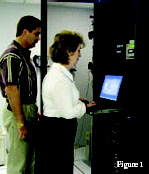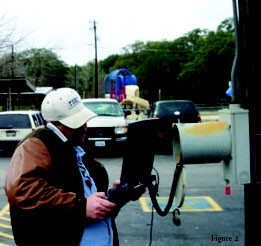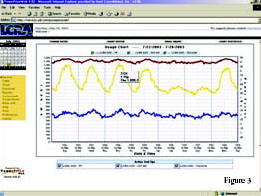
Daily meter readings, metered data posted daily to secure websites, annual meter inspections, quick diagnosis of metering problems and coordination of meter repair—these are the backbone services of the Lower Colorado River Authority’s (LCRA) support for its customers’ major accounts. As public utilities, the LCRA and its customer base, nine rural electric cooperatives and 33 municipal utilities, are not subject to the competitive retail electric market in Texas. Deregulation, however, has forced LCRA to prepare for a changed market.
The intent of LCRA’s Key Account Program is energy education through access to interval data—the tool that provides the load shapes and energy use patterns that help consumers understand their electric bills. While LCRA and its utility customers use this data to educate their consumers, they have derived a second benefit from the Key Account Program—improved meter management and detecting service problems.
LCRA offers data collection and metering support services through two Texas-based contractors — MeterSmart Services™ (formerly Utility Data Resources, Inc.) of Arlington and Texas Meter and Device (TMD) of Waco. Since its inception in 2000, this arrangement has grown into a partnership among LCRA, MeterSmart, and TMD. Funding is coordinated under LCRA’s energy services program called TexasWi$e™. By participating in TexasWi$e, the distribution companies can select the level of support they want from a menu of metering and data collection services, all for the cost of only a few dollars on their monthly wholesale power bills.
Catching Damage Early
The effects of one unusual winter storm in Brenham, Texas on the last day of 2002 illustrate the workings of this new partnership. Summer-like violent lightning and thunder accompanied the driving rain in that late December storm. The next working day, January 2, 2003, MeterSmart’s Norma Jackson reviewed her morning’s meter readings. She reads approximately 300 meters daily for Brenham and the 31 other utilities that take advantage of the Key Accounts Program. Looking over the reports from her MV-90 system (Figure 1), she saw that data from a number of meters in Brenham was out of whack. With a few phone calls and e-mails, Jackson set in motion the diagnosis and repair of the problems she detected.
By the time the meter technicians had completed their field work, they found that eight of Brenham’s 26 major accounts had suffered damaged or destroyed meters or current transformers or both (Figure 2). All were repaired in time for the January billing cycle, ensuring that Brenham had accurate and timely data for its biggest customers.
Brenham meter technician Davin Jezierski finds daily meter readings useful in other ways. Before those 26 meters were read remotely by telephone, he’d hustled to collect billing data manually one day each month. He then spent the following two days pulling reports from his readings, then culling through them for the data he put into the billing system. Outages posed a particular problem. “One time, a meter went out the day after I’d read it, so I had to estimate a whole month’s data on that customer,” says Jezierski.
He explained that before meters were read remotely, he would estimate a customer’s energy use from historical energy and demand records but without interval data. Now instead of Jezierski’s spending three days putting together the bills for his major accounts, MeterSmart collects the data and ships it to LCRA for billing. Jackson fills in any missing intervals using utility standard verification and editing protocols, saving Jezierski and others from having to do it manually. The early detection of meter failures makes his work easier. “The best part of this program is the night time reads when I find out the next day if there’s a problem,” says Jezierski.
Both he and Brenham profit also from finding the annual meter testing LCRA offers through its contract with TMD. Especially useful, Jezierski said, is catching failed current transformers (CTs). When a CT no longer works on one leg of three-phase service, the meter can’t record all the power a customer uses. The bill is inaccurately lower, costing the municipal utility money until it discovers the error. After the CT is replaced, the bill goes up, and the utility has to explain to the customer that its measurement systems weren’t accurate.
Meter accuracy is critical. “Everything stems from that meter working properly. That’s our foundation, it’s our measuring system,” states Deena Locklear, who manages billing for Cap Rock Electric’s McCulloch Division in Brady, Texas, an early participant in the LCRA project. Her utility depends on the TMD service, as she says, “We’re pretty limited on the resources available to us, and they’re very good.”

Origins of the Partnership
The combination of the MeterSmart/TMD partnership came about in 2000 after LCRA concluded that its regulated transmission group, which had included meter services for its wholesale customers and meter reading for a number of their customers, could no longer deal with any retail consumers. It phased out its consumer-level metering work and looked around for an outsider to read the retail meters. The solution was to outsource the meter work to TMD and the data translation support to MeterSmart. Over three years, this arrangement has grown into a partnership that LCRA customers find beneficial.
The range of services supports those distribution entities that can do most of their meter work alone and enables smaller ones to rely entirely on TMD’s shop. TMD installs advanced meters with interval data recorders on accounts identified by the co-op or municipal staff. Each installation includes a full check of the meter service equipment, verification of the accuracy of CTs and meter multipliers, and an annual check. Included in the full-service package is a guarantee for replacing broken meters at no cost, a benefit to a municipality like Brenham that saw two recorders worth almost a thousand dollars each die in one storm. MeterSmart works with the field technicians at the time of installation to set up the meter’s formal record in MV-90 and then reads the meters daily. It posts daily reads to secure websites for each distribution company and consumer.
Data on the Web-Applications
Utility staffs find several uses for the web-based data. Locklear depends on the web postings both for billing and customer service. She’s had MeterSmart reading her three largest customers’ meters and posting the data daily to the utility’s website. “I get the information right off the Internet and bill them like that,” she said. Doing it that way saves her staff a lot of time. Cap Rock also uses the web presentation to assist it with customer concerns. Not long after MeterSmart began its web posting, Cap Rock’s field supervisor got a call from one customer who’d complained about an outage over a weekend. While Cap Rock couldn’t see the down time in any of its records, it could pull the load curve from the web and see when the service failed and resumed. As Locklear explains, “It lets us see what our customers are doing and when they’re doing it.”

Not only have customers seen the benefits of daily monitoring of their retail accounts, so also has LCRA (Figure 3). As a wholesaler, LCRA delivers power to substations where the distribution companies take ownership of electricity after it is stepped down from transmission to distribution voltage. LCRA meters and bills at that exchange point, and billing takes place on the 25th of each month. Recently on billing day, the billing system flagged a discrepancy at one of the substations providing power to Cap Rock Electric. Two of its major accounts drawing power from that substation are metered in the LCRA program. The problem the billing system detected was that the sum of the plants’ energy for the billing period was greater than the energy measured at the substation.
Because the meter for one plant had failed and been replaced that month, the original assumption was that the estimated data for the outage was too high. Billing and customer service staff at LCRA undertook an inquiry into the load history. What they found was that the substation’s peak demand for the month was much lower than normal. The load curve had remained constant, so the LCRA Data Translation group that reads and examines substation data on a daily basis had not noticed the lower peak. Working in partnership, LCRA and MeterSmart re-examined the data and discovered that the substation’s load appeared to have dropped about a third late in the billing month. The next day one of one of LCRA’s substation metering specialists found that the current transformer for one phase of the substation meter had cracked. LCRA estimated the few days’ missing data and sent Cap Rock an accurate bill. The cooperative effort averted the loss of measuring millions of kilowatt-hours before an annual meter inspection would have found the failed CT. Further, neither LCRA nor Cap Rock had to deal with billing a customer for a corrected read that would have cost the customer more money.
End-use consumers use the web data, too. Peter Koestler is the engineer responsible for managing energy at the Spoetzl Brewery in Shiner, Texas, a municipal utility that uses the full meter and data collection package offered under TexasWi$e. MeterSmart reads the meters at Spoetzl, whose Shiner Bock beer is a regional favorite, and posts the data to Spoetzl’s secure web site. “We download the raw data and create graphic representations according to our production schedule,” Koestler explained. “We’re trying to find out what happened at the time we see an energy peak, to understand it and see if it makes sense to adjust what we can do to avoid the peak.” Brewing beer, of course, takes precedence in his work, but Koestler pointed out, “We’re always exploring cost savings, and the tools we get from LCRA are a great source of information.”
The Meter - Point of Convergence
Comments like those above perfectly characterize the original intent of LCRA’s Key Accounts effort—to provide customer education through web-based presentation of real-time interval data. Through Shiner and LCRA, seeing his data on the web whenever desired enables Koestler, and scores of consumers like him, to make timely decisions based on up-to-date energy information. However, no one foresaw the benefits emerging from the distribution and transmission management applications of the daily meter reading process. Truly, the cash register of the electric utility industry is the meter itself. Interviewing it on a daily basis not only provides a useful way to build customer energy awareness, but also transforms the meter into a valuable witness for early detection of system problems, thus preventing or minimizing potential revenue loss.
About the Author:
Tom Knutsen is an energy services consultant for the Lower Colorado River Authority (LCRA) in Austin, Texas. He and a co-worker share responsibility for the meter and communications infrastructure, data collection, and billing data delivery for key end-use consumers served by LCRA’s wholesale customers. LCRA is helping its customers prepare for the deregulated, retail, electric market in Texas by educating their principal consumers on electric pricing and services. Knutsen has worked at LCRA since 1981 in various capacities involving residential demand-side management, industrial load management, DSM evaluation, end-use consumer pricing, and customer service. Before LCRA, he spent five years as a beat reporter for daily newspapers. He holds an A.B. in history from Yale College and an M.A. in communication from the University of Texas at Austin.
Captions:
Figure 1: MeterSmart’s Rusty McCloud and Norma Jackson oversee the company’s MV-90 data translation servers.
Figure 2: TMD technician Mike Lewis programs a meter while calling MeterSmart Services to configure the meter in MV-90.
Figure 3: MeterSmart’s PowerPrice™ Web shows meter data collected as recently as the previous day. It is easy to access and manipulate, and stays current. Shown here is a graphic display of the weekly energy usage at LCRA’s Austin, Texas office.







